|

by Matt Williams
October
12, 2018
from
UniverseToday Website
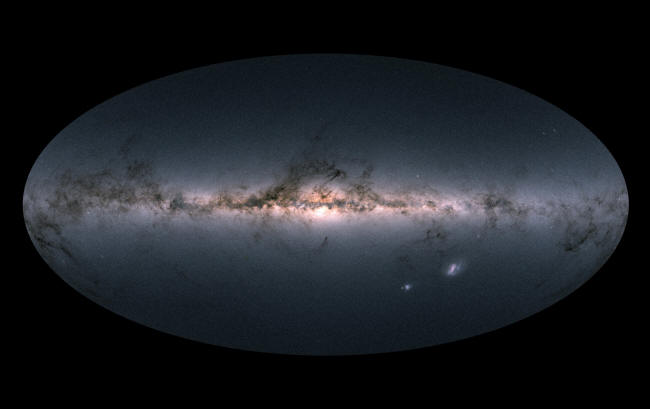
For almost two centuries, scientists have theorized that life may be
distributed throughout the Universe by meteoroids, asteroids,
planetoids, and other astronomical objects.
This theory, known as
Panspermia, is based on the idea that microorganisms and the
chemical precursors of life are able to survive being transported
from one star system to the next.
Expanding on this theory, a team of researchers from the Harvard
Smithsonian Center for Astrophysics (CfA) conducted a study that
considered whether panspermia could be possible on a galactic scale.
According to the model
they created, they determined that the entire Milky Way (and even
other galaxies) could be exchanging the components necessary for
life.
The study, "Galactic Panspermia", recently appeared online and is
being reviewed for publication by the Monthly Notices of the Royal
Astronomical Society.
The study was led by Idan Ginsburg, a visiting
scholar at the CfA's Institute for Theory and Computation (ITC), and
included,
-
Manasvi Lingam -
ITC postdoctoral researcher and director of the ITC
-
Abraham Loeb - Frank B. Baird Jr.,
Chair of Science at Harvard University
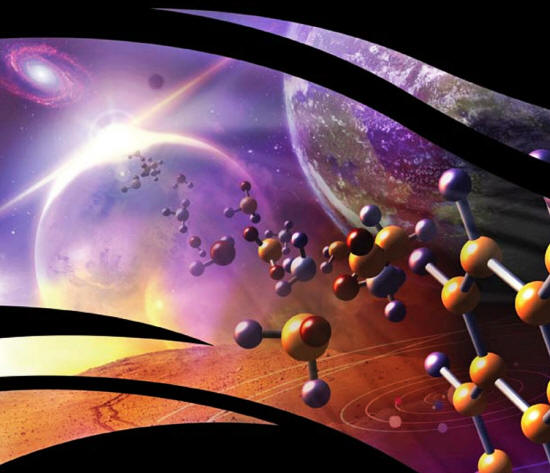
A new study expands on
the
classical theory of panspermia,
addressing whether or not life
could
be distributed on a galactic scale.
Credit:
NASA
As they indicate their study, most of the past research into
panspermia has focused on whether life could had been distributed
through the Solar System or neighboring stars.
More specifically,
these studies addressed the possibility that life could have been
transferred between Mars and Earth (or other Solar bodies) via
asteroids or meteorites.
For the sake of their study, Ginsburg and
his colleagues cast a wider net, looking at the Milky Way Galaxy and
beyond.
As Dr. Abraham Loeb told Universe Today via email, the
inspiration for this study came from the first-known interstellar
visitor to our Solar System - the
asteroid 'Oumuamua:
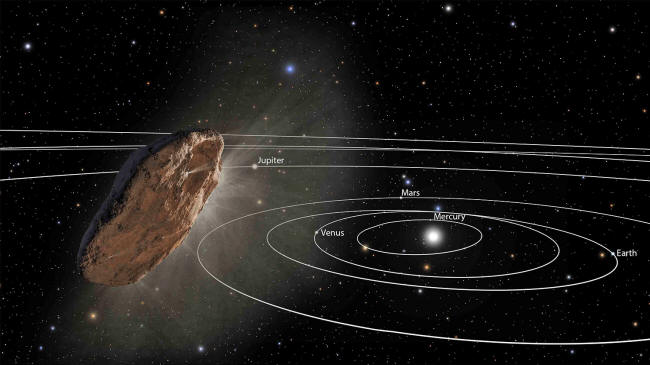
Interstellar object 'Oumuamua exits the Solar System
Wikipedia
"Following that
discovery, Manasvi Lingam and I wrote a paper where we showed
that interstellar objects like 'Oumuamua could be captured
through their gravitational interaction with Jupiter and the
Sun.
The Solar System acts as a gravitational
'fishing net' that
contains thousands of bound interstellar objects of this size at
any given time.
These bound interstellar objects could
potentially plant life from another planetary system and in the
Solar System.
The effectiveness of the fishing net is larger for
a binary star system, like the nearby
Alpha Centauri A and B,
which could capture objects as large as the Earth during their
lifetime."
"We expect most
objects to likely be rocky, but in principle they could also be
icy (cometary) in nature," Ginsburg added.
"Regardless of
whether they are rocky or icy, they can be ejected from their
host system and travel potentially thousands of light-years
away. In particular
the center of the galaxy can act as a
powerful engine to seed the Milky Way."
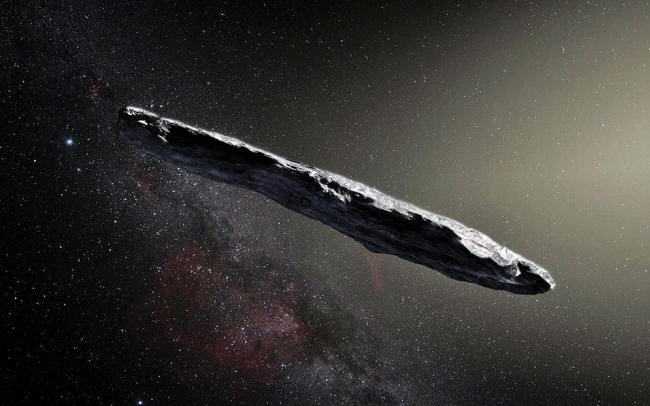
Artist's impression of the first
interstellar asteroid/comet, "Oumuamua".
This unique object was discovered on 19 October 2017
by the Pan-STARRS 1 telescope in Hawaii.
Credit: ESO/M. Kornmesser
This study builds on previous research conducted by Ginsburg, Loeb
and Gary A. Wegner of the Wilder Lab at Dartmouth College.
In a 2016
study (Hypervelocity
Planets and Transits Around Hypervelocity Stars) published in the Monthly Notices of the Royal Astronomical
Society, they suggested that the center of the Milky Way could be
the instrument through which hypervelocity stars are ejected from a
binary system and then captured by another system.
For the sake of this study, the team created an analytic model to
determine just how likely it is that objects are being traded
between star systems on a galactic scale.
As Loeb explained:
"In the new paper we
calculated how many rocky objects that are ejected from one
planetary system can be trapped by another one across the entire
Milky Way galaxy.
If life can survive for a million years, there
could be over a million 'Oumuamua-size objects that are captured
by another system and can transfer life between stars.
Therefore panspermia is not exclusively limited to solar-system sized
scales, and the entire Milky Way could potentially be exchanging
biotic components across vast distances."
"[O]ur physical model calculated the capture rate of objects in
the Milky Way which strongly depend upon velocity and the
lifetime of any organisms that may travel on the object," added
Ginsburg.
"No one had done such a calculation before, and we
feel this is quite novel and exciting."
From this, they found
that the possibility of galactic panspermia came down to a few
variables.
-
For one, the capture rate
of objects ejected from planetary systems is dependent on the
velocity dispersion as well as the size of the captured object.
-
Second, the probability that life could be distributed from one
system to another is strongly dependent upon the survival lifetime
of the organisms.
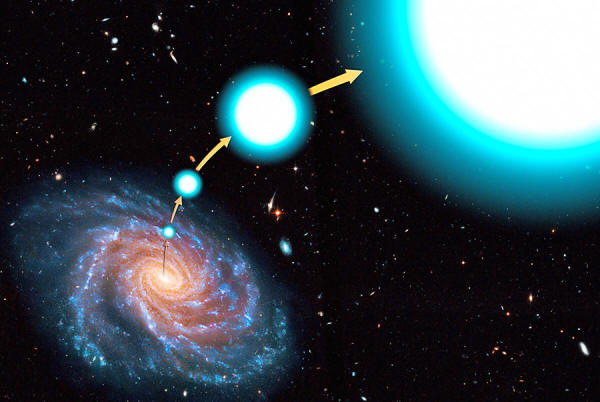
An artist's conception
of a
hypervelocity star
that
has escaped the Milky Way.
Credit:
NASA
However, in the end they found that even in the worst case
scenarios, the entire Milky Way could be exchanging biotic
components across vast distances.
In short, they determined
panspermia is viable on galactic scales, and even between galaxies.
As Ginsburg said:
"Smaller objects are
more likely to be captured.
If you consider Saturn's moon
Enceladus (which is very interesting in itself) as an example,
we estimate that as many as 100 million such life-bearing
objects may have traveled from one system to another!
Again, I
think it's important to note that our calculation is for
life-bearing objects."
The study also bolsters
a
possible conclusion raised in two previous studies conducted by Loeb
and James Guillochon (an Einstein Fellow with the ITC) back in 2014.
-
In the first study
(Observational
Cosmology With Semi-Relativistic Stars), Loeb and Guillochon traced the presence of
hypervelocity stars (HVSs) to galactic mergers, which caused them to
leave their respective galaxies at semi-relativistic speeds -
one-tenth to one-third the speed of light.
-
In the second study
(The
Fastest Unbound Stars in the Universe), Guillochon and Loeb determined that there are
roughly a trillion HVSs in intergalactic space and that
hypervelocity stars could bring their planetary systems along with
them.
These systems would therefore be capable of spreading life
(which could even take the form of
advanced civilizations) from one
galaxy to another.
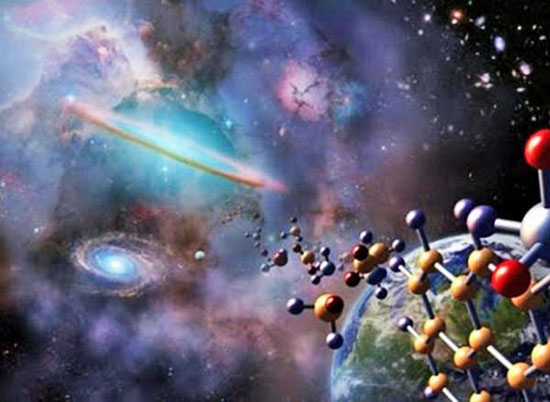
In addition to small objects (like meteoriods),
life
could be distributed throughout our galaxy
by
interstellar asteroids,
and
between galaxies by stars systems.
Credit:
NASA/Jenny Mottor
"In principle, life
could even be transferred between galaxies, since some stars
escape from the Milky Way," said Loeb.
"Several years ago, we
showed with Guillochon that the Universe is full of a sea of
stars that were ejected from galaxies at speeds up to a fraction
of the speed of light through pairs of massive black holes
(formed during galaxy mergers) which act as slingshots.
These
stars could potentially transfer life throughout the Universe."
As it stands, this study
is sure to have immense implications for our understanding of life
as we know it.
Rather than coming to Earth on a meteorite, possibly
from Mars or somewhere else in the Solar System, the necessary
building blocks for life could have arrived on Earth from another
star system (or another galaxy) entirely.
Perhaps someday we will encounter life beyond our Solar System that
bears some resemblance to our own, at least at the genetic level.
Perhaps we may even come across some advanced species that are
distant (very distant) relatives, and collectively ponder where the
basic ingredients that made us all possible came from.
|







